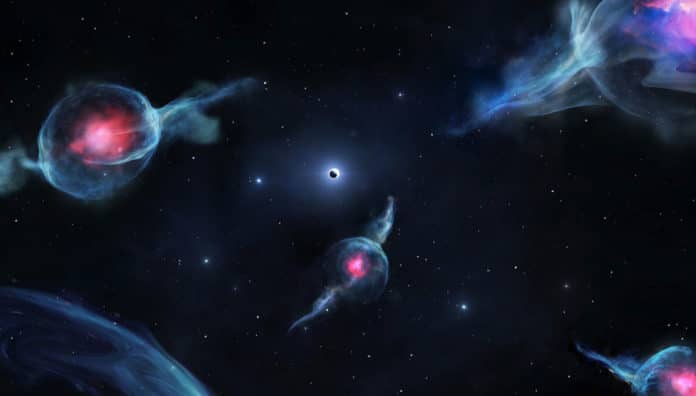Our galaxy’s supermassive black hole called Sagittarius A* (or Sgr A*), constantly pull stars, dust, and other matter inward, forming a stellar megalopolis 1 billion times denser than our corner of the galaxy.
Recently, four unusual objects are closely orbiting Sagittarius A*, which are now forming a class of their own.
Co-author Andrea Ghez, UCLA’s Lauren B. Leichtman and Arthur E. Levine Professor of Astrophysics and director of the UCLA Galactic Center Group said, “These objects look like gas but behave like stars.”
This new class of objects, called G objects, are unresolved, and they show both thermal dust emission and line emission from ionized gas. Compact in look, the objects stretch out when their orbits bring them closest to the black hole. Their orbits range from about 100 to 1,000 years.
The objects have been labeled as G3, G4, G5, and G6. This set is in addition to the first pair of G objects found near the Galactic Center; G1 was discovered by Ghez’s research group in 2005, followed by G2.
When scientists determined the orbits of each object, they found that G1 and G2 have similar orbits, G3, G4, G5, and G6 all have very different orbits.
Co-author Mark Morris, UCLA professor of physics and astronomy, said, “One of the things that have gotten everyone excited about the G objects is that the stuff that gets pulled off of them by tidal forces as they sweep by the central black hole must inevitably fall into the black hole. When that happens, it might be able to produce an impressive fireworks show since the material eaten by the black hole will heat up and emit copious radiation before it disappears across the event horizon.”
“All six objects were binary stars — a system of two stars orbiting each other — that merged because of the strong gravitational force of the supermassive black hole. The merging of two stars takes more than 1 million years to complete.”
“Mergers of stars may be happening in the universe more often than we thought, and likely are quite common. Black holes may be driving binary stars to merge. It’s possible that many of the stars we’ve been watching and not understanding may be the end product of mergers that are calm now. We are learning how galaxies and black holes evolve. The way binary stars interact with each other and with the black hole is very different from how single stars interact with other single stars and with the black hole.”
The observations were made using powerful technology that Ghez helped pioneer at Keck Observatory called adaptive optics (AO), which corrects the distorting effects of the Earth’s atmosphere in real-time. AO, combined with Keck Observatory’s OH-Suppressing Infrared Imaging Spectrograph (OSIRIS), allowed the team to obtain spectroscopic measurements of the Galactic Center’s gas dynamics.
The National Science Foundation funds the research, W. M. Keck Foundation, Keck Visiting Scholars Program, the Gordon and Betty Moore Foundation, the Heising-Simons Foundation, Lauren Leichtman, and Arthur Levine, Jim and Lori Keir, and Howard and Astrid Preston.
The results are published online today in the journal Nature.
